by Heidi Copeland | Apr 1, 2016
Can you believe Florida fresh fruits and veggies are supplied to 160 countries around the globe! Particularly abundant right now are the vegetables commonly referred to as cruciferous vegetables. (However, many scientists are starting to favor the term brassica vegetables over cruciferous vegetables) These nutritious veggies are ones that you will want to eat on a regular basis as they are bursting with both macronutrients and micronutrients.
The Florida Department of Agriculture and Consumer Services lists, cabbage, cauliflower, and radishes as being abundant in April for world production. Locally though, growers are turning out broccoli, cabbage, cauliflower, collard greens, kale, kohlrabi, mustard, rutabaga, turnips, bok choy, Chinese cabbage and arugula, as well as radishes.
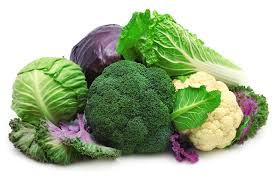 There are many simple ways to include cruciferous/brassica vegetables into your diet.
There are many simple ways to include cruciferous/brassica vegetables into your diet.
- Eat them raw! Raw vegetables can make a delicious, crunchy snack especially when served with a low-fat dip.
- Use in recipes! Make slaw, soup or salad, main dishes and even condiments!
- Substitute! Did you know steamed, mashed cauliflower can replace mashed potatoes? Or that coarsely grated cauliflower can replace rice? Folks have even substituted a cauliflower mixture as pizza crust! (okay, it might be a stretch but it does taste good)
Shopping, preparing and storing
- Cruciferous/brassica vegetables are typically inexpensive and can also be found year-round, fresh or frozen.
- Store raw, uncut and unwashed vegetables in the crisper drawer of your refrigerator for up to five days.
Cooking methods:
There are three factors affecting nutrient loss when you cook cruciferous/brassica vegetables:
- Temperature
- Time
- Amount of water used.
The cooking method that best retains nutrients is one that cooks quickly, heats food for the shortest amount of time, and uses as little liquid as possible.
- Using the microwave with a small amount of water essentially steams food from the inside out keeping more vitamins and minerals than almost any other cooking method. http://www.health.harvard.edu/
- Steam vegetables over a small amount of boiling water until a fork can just barely pierce it. (You can save the nutrients that are lost when steaming cauliflower by using the leftover water in a soup)
- Braise, bake or broil, stir-fry or sauté
Cruciferous/brassica vegetables are very unique in that the flower, the root, the stalk and even the leaves can be eaten depending on which plant you are eating.
Try a cruciferous/brassica vegetable a new way or even try a new cruciferous/brassica vegetable a traditional way!
Cauliflower Salad
(Or even use a combination of cauliflower and broccoli and kohlrabi)
Ingredients
2 Tablespoons sliced or diced onion, red, green or white
1 head of cauliflower – including the tender stems, cut into small pieces (or even cut into small florets)
1 Tablespoon sugar
1 Tablespoon vinegar (red wine, white wine, apple cider, or rice wine)
¼ cup mayonnaise
½ cup dried cranberries (or favorite dried fruit)
Salt and pepper to taste
In a large bowl, whisk the sugar, vinegar and mayonnaise together. Season with salt and pepper. Toss in the onion, cauliflower and cranberries and stir until well coated. Eat it right away or savor for a few days.
http://www.freshfromflorida.com/content/download/16796/269931/04April.pdf
by Heidi Copeland | Feb 23, 2016
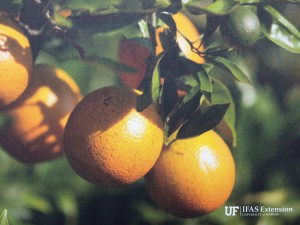 What’s in season now is certainly variable, location being a major influence in this area. Chances are, if you’re from a cold weather state and enjoying the Florida sunshine, expectations are a bit different than if you are from around these parts. Nonetheless, according to the Florida Department of Agriculture and Consumer Services (FDACS), oranges are not a variable here. They are one of the most popular fruits- folks from around the globe know about Florida. For instance, did you know that the orange is the official Florida fruit? It’s no surprise that orange juice is the official Florida state beverage and the orange blossom is Florida’s state flower.
What’s in season now is certainly variable, location being a major influence in this area. Chances are, if you’re from a cold weather state and enjoying the Florida sunshine, expectations are a bit different than if you are from around these parts. Nonetheless, according to the Florida Department of Agriculture and Consumer Services (FDACS), oranges are not a variable here. They are one of the most popular fruits- folks from around the globe know about Florida. For instance, did you know that the orange is the official Florida fruit? It’s no surprise that orange juice is the official Florida state beverage and the orange blossom is Florida’s state flower.
Oranges, a member of the citrus family along with other seasonal favorites like grapefruit and tangerine, are considered a nutrient dense food. Oranges provide valuable calories in the form of carbohydrates and fiber plus they are high in vitamin C, the minerals potassium and phosphorus, plus other nutrients. Not only do Florida oranges make for a delicious, refreshing FAST FOOD when eaten right out of the hand, they can be easily peeled and sectioned, zested, or juiced to add flavor and nutrition to many recipes. Oranges flavor well with other seasonal fresh foods, too. According to FDACS they pair nicely with basil, chocolate, cinnamon, ginger, mangoes, olives, pecans, strawberries and vanilla. Florida oranges can even make a beautiful garnish to enhance a beverage or dinner plate.
Expand your use of the Florida orange this October-June growing season by trying these simple tips:
Squeeze your own juice! Use it to:
- Give seasonal vegetables a new taste
- Make a simple marinade for poultry
- Enhance the flavor of a fruit salad or beverage
Zest an orange!
- Zest can be added to many dishes to enhance flavor (rice, vegetables, baked goods, beverages, salads)
- Care should be taken not to remove the white pith along with the peel as this can be bitter.
Peel an orange! Add the segments to:
- Garden fresh salads
- Pasta
- Poultry recipes
When choosing Florida fresh oranges, choose one that is firm and heavy for its size. Refrigerating prolongs the life an orange.
Why eat seasonally? Products are fresher and tastier, and nutritional value is optimized. Not only are oranges plentiful this time of year, but other seasonal produce is bountiful too. Try some fresh local Florida produce today!
http://www.freshfromflorida.com/content/download/16795/269924/03March.pdf
Orange and Tupelo Honey Bliss
(a delicious salad dressing, marinade or dipping sauce)
1 Teaspoon fresh grated orange *zest
Juice of one fresh Florida orange
1/4 cup Tupelo honey
1/4 cup plain vinegar
1/4 cup olive oil
Combine all ingredients and mix well.
Personalize this recipe by adding dried or fresh herbs, garlic, peppers or other Florida fresh citrus zest* and juice.
*Zest, also known as citrus peel, is a food ingredient that is prepared by scraping or cutting from the outer, colorful skin of or citrus fruit.
by Heidi Copeland | Feb 20, 2016
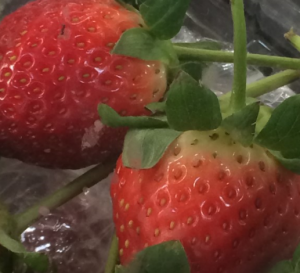 Although cool weather certainly makes Floridians feel like they’re experiencing winter, Florida farms are working in overdrive this February producing agricultural products for a whole lot of people who, because of COLD weather, are not able to grow their own crops. .
Although cool weather certainly makes Floridians feel like they’re experiencing winter, Florida farms are working in overdrive this February producing agricultural products for a whole lot of people who, because of COLD weather, are not able to grow their own crops. .
The Florida Department of Agriculture and Consumer Services states that “Consumers around the world look for and value the “Fresh From Florida” label”. Because seasonal products are fresher and tastier, nutritional value is optimized. Often, seasonal products are more economical. In fact, fall plantings are not only being labeled as Fresh from Florida but also as what is in season right now. February’s list is quite impressive; especially when you think about the delicate nature of a strawberry!
Can you believe that each winter close to 300 million pounds of strawberries are grown in Central Florida, earning the area around Plant City the title Winter Strawberry Capital of the World!
Florida strawberries are indeed delicious and they’re full of Vitamin C and other vitamins and minerals – a real nutrient dense food.
When shopping for Florida Fresh strawberries:
- Know that strawberries, once picked, do not ripen further.
- Only purchase strawberries that can be consumed in a few days. Even when properly stored in a refrigerator, strawberries last only a few days.
Choose berries that are:
- Firm, plump, and free of mold.
- Shiny, deep red in color with attached green caps.
Avoid strawberries that are:
- Dull in color or have green or yellow patches.
If you are buying strawberries prepackaged in container ensure:
- Strawberries are not packed too tightly (which may cause them to become crushed and damaged.
- The container has no signs of stains or moisture, (indication of possible spoilage).
- The cap, stem and white hull remain intact (this prevents unnecessary loss of moisture).
- Strawberries are not left at room temperature or exposed to sunlight (this aides in their spoiling).
Since strawberries are very perishable, strawberries should not be washed until right before eating or using in a recipe.
- Do not remove strawberry caps and stems until after they have been gently washed under cold running water and patted dry. This will prevent them from absorbing excess water, which can degrade strawberries’ texture and flavor and cause them to spoil.
To freeze strawberries:
- Gently wash strawberries and pat dry. The cap and stem can either be removed or left intact, depending upon what you will do with them once they are thawed.
- Arrange strawberries in a single layer on a flat pan or cookie sheet and place them in the freezer. (lining the tray with a piece of parchment paper makes for easy removal once frozen)
- Once frozen, transfer the strawberries to a heavy plastic bag and return them to the freezer where they will keep for up to one year.
Try these simple ideas for including strawberries in your next meals and snacks:
- Strawberry and Spinach Salad
- Strawberry-Banana Smoothie
- Strawberry, Pistachio and Goat Cheese Pizza
Fore more information, contact: http://strawberrysue.com/
http://www.freshfromflorida.com/Divisions-Offices/Marketing-and-Development/Consumer-Resources/Buy-Fresh-From-Florida/Crops-in-Season
by Heidi Copeland | Jan 11, 2016
Goodness, it is freezing cold in most parts of the country and Florida is gearing up for a record breaking harvest season!
According to the Florida Department of Agriculture and Consumer Services (FDACS) Florida commercial farms rank second in the U.S. for value of vegetable production; first in production value for oranges (accounts for 63 percent of total U.S. citrus production), fresh market tomatoes, watermelons, grapefruit, fresh market snap beans, fresh market cucumbers and squash; second in the production of greenhouse and nursery products, bell peppers, strawberries, fresh market sweet corn, spring potatoes, tangerines and avocados. Florida ranks eighth in agricultural exports with over $4 billion in receipts.
It may be winter but wintertime in Florida is an incredible season for Florida agriculture. Look for these “Fresh From Florida” items in your grocery store during January: avocado, bell pepper, broccoli, cabbage carambola, cauliflower, celery, eggplant, grapefruit, guava, lettuce, mushroom, orange, passion fruit, peanut, radish, sap bean, squash, strawberry, sweet corn, tangerine, tomato.
http://www.freshfromflorida.com/content/download/16793/269910/01January.pdf
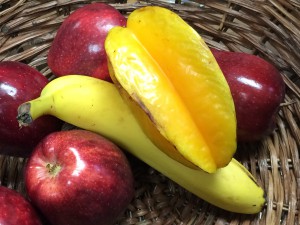
Starfruit
And why not try something new?
According to the Tropical Fruit Growers of South Florida carambola, commonly known as a starfruit is just getting started and will continue into February. These lightly sweet fruits are crisp, juicy and perfect for adding to meals and desserts as well as for just snacking on.
If you purchase a carambola buy one with little or no bruising or brown spots on the ribs. Starfruit that is ready to eat is gold in color. If you can wait a few days, select a starfruit that is a light yellow, with a hint of green along the ribs because carambola that is yellow or a very light green will ripen on the counter at room temperature. (Don’t place it in the refrigerator as this will stop the ripening process.) Once the carambola is ripe, wash the fruit and then cut it crosswise to reveal its beautiful star pattern. The skin, the seeds and core are all edible, and delicious!
Ripe carambola can be stored in the refrigerator; it will keep for almost a week. Be aware that a frozen carambola will change consistency when thawed but can be successfully added to a smoothie along with other fruit.
Carambolas are a nutritious, low calorie fruit, and are a great addition to healthy meals and snacks. Try one!
Try this easy recipe found the Tropical Fruit Growers of South Florida website. http://www.tfgsf.com/?page_id=545
Carambola and Lettuce Salad
1 head of Romaine Lettuce, washed and dried
2 large or 3 medium Carambolas sliced in their beautiful star patterns
2 T Balsamic Vinegar
4 T olive oil
2 T chopped mint
Salt and pepper to taste
On a large plate fan out the lettuce leaves, going all the way around making a ring and making a second layer if needed. (Larger leaves first and smaller ones subsequently) Lay the carambola slices in the center.
Combine the vinegar, olive oil, chopped mint, salt and pepper and drizzle over the salad.
Serves four
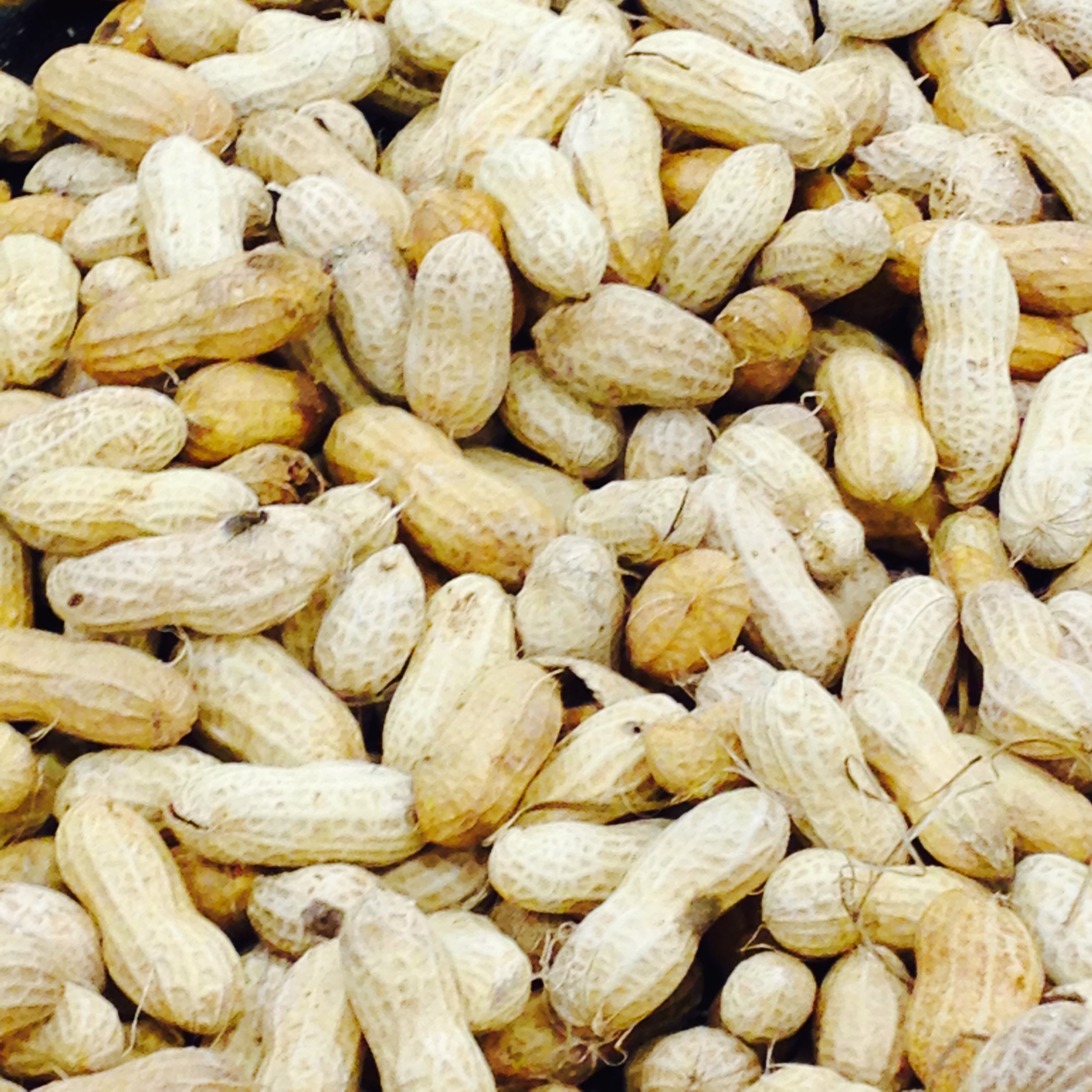
by Heidi Copeland | Oct 2, 2015
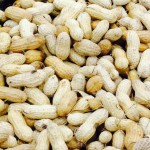 Geographic conditions have a major impact on the growing season of any given area. Florida is indeed blessed to have such diverse and healthy growing times. In fact, Florida is one of the few states divided into three plant and hardiness zones (south, central, and north), allowing Florida produce to be successfully grown somewhere in Florida year-round.
Geographic conditions have a major impact on the growing season of any given area. Florida is indeed blessed to have such diverse and healthy growing times. In fact, Florida is one of the few states divided into three plant and hardiness zones (south, central, and north), allowing Florida produce to be successfully grown somewhere in Florida year-round.
Locally, our area is fortunate to have two distinct produce-growing seasons. Both seasons are very accommodating to fruit and vegetables. According to the Florida Department of Agriculture and Consumer Services (FDACS), avocado, carambola, grapefruit, guava, mushrooms, oranges, peanuts, and tangerines are Fresh from Florida® this month.
In addition, the local Red Hills Small Farm Alliance produces a great guide to what grows in our area (www.rhomarket.com). Local produce includes arugula, Asian greens, cucumbers, eggplant, garlic, okra, southern peas, sweet peas and sugar snap peas, peppers, potatoes, radishes, yellow squash and zucchini, acorn squash and pumpkin, Muscadine grapes, pears, and persimmons.
When wanting to incorporate seasonal items into a meal, peanuts are not usually something that comes to mind. However, peanuts are becoming abundant this time of year. According to the Peanut Institute, “While ‘nut’ is in their name, peanuts are, in fact, legumes. Peanuts actually grow underground, as opposed to nuts like walnuts, almonds, etc. that grow on trees (and are sometimes referred to as ‘tree nuts’).”
Peanuts, along with beans and peas, belong to the single plant family, Leguminosae. Legumes are edible seeds that are enclosed in pods. As a group, they provide the best source of concentrated protein in the plant kingdom.
In the U.S., peanuts and peanut butter are the most popular “nut” choice and comprise 67% of all nut consumption. Plus, you can do more with peanuts than just eat them as a snack! Have you ever considered peanuts as a major nutrient in your meals? Peanut Butter–Sriracha Toast is becoming a big hit, as it can be served as a snack, appetizer, and even as light lunch or dinner fare.
Even the George Mateljan Foundation, a not-for-profit foundation interested in helping folks make healthy eating easier, considers peanuts one of the world’s healthiest foods. Peanuts are a plant food rich in vitamins, minerals, and phytonutrients and also contain protein, mostly good fats, and fiber.
It is fun (and healthy) to experiment with local, Florida fresh produce anytime of the year. Why not try something new and incorporate peanuts into your favorite meals? In fact, peanut soup is an old-time favorite but can be made into a new taste sensation using many of the ingredients you find locally this fall. Try some today using the recipe listed below to fit your family’s tastes.
Peanut Butter Soup
2 cups peanut butter
6 cups chicken or vegetable broth
3 tablespoons peanut oil
1 onion, chopped
2 celery ribs (chopped, including leaves)
2 garlic cloves, minced
Pepper
Salt
Preparation
- Add the oil to a heavy sauce pan; sauté onion, celery, and garlic in the oil until tender.
- Add chicken or vegetable broth and any other vegetable you plan on using.
- Cook, covered, until the vegetables are softened.
- Stir in the peanut butter.
- Add your own take on this delicious soup…
Do you like velvety smooth soups? Carefully puree the entire mixture in batches in a blender or use an immersion blender.
Do you like it spicy? Add some fresh, hot pepper, dry peppers, or hot sauce.
Vary the texture and flavor: Add cubed squash, pumpkin, potatoes, peas, or even sliced okra.
To suggest an Asian flare, add some coconut milk and cilantro or even rice wine vinegar.
Source: http://www.freshfromflorida.com/Divisions-Offices/Marketing-and-Development/Consumer-Resources/Buy-Fresh-From-Florida/Crops-in-Season
 There are many simple ways to include cruciferous/brassica vegetables into your diet.
There are many simple ways to include cruciferous/brassica vegetables into your diet.




